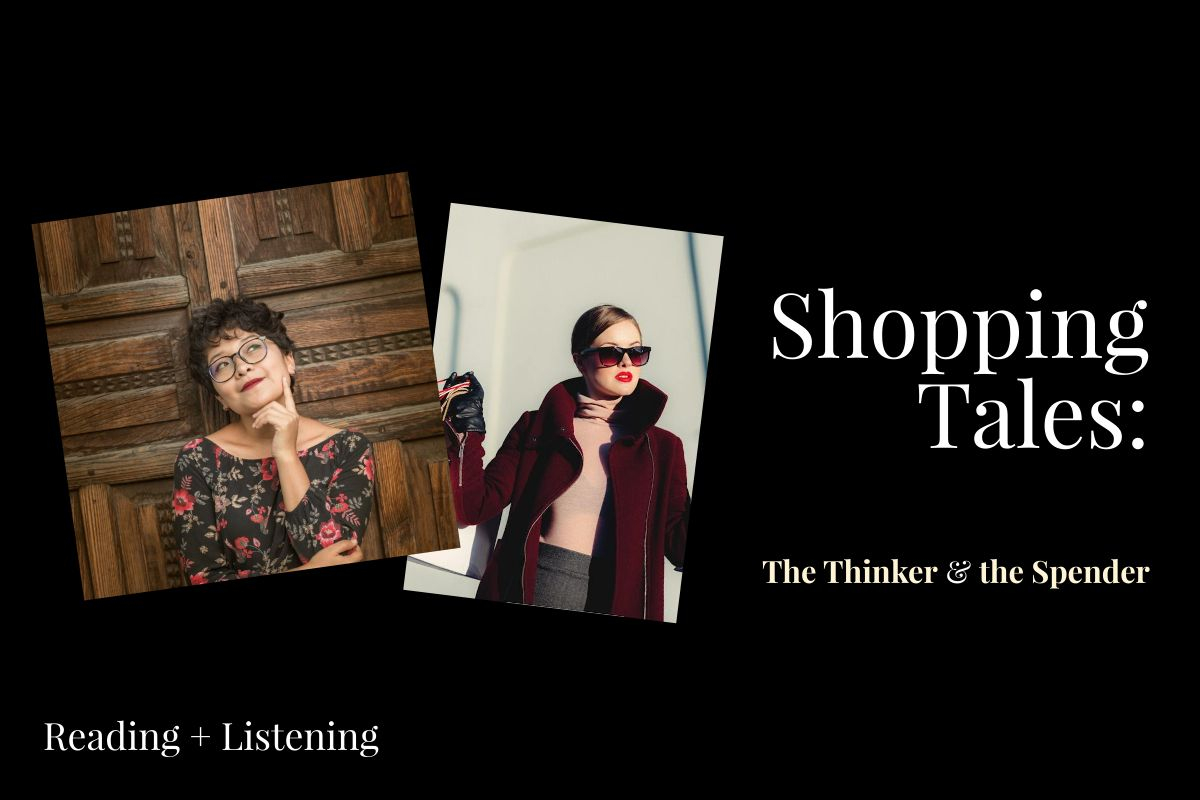
Introduction
Shopping is a common activity that many people enjoy. Whether it is for groceries, clothes, electronics, or anything else, shopping can be fun and satisfying. However, shopping can also be a source of stress and frustration, especially if you don’t plan ahead and stick to your budget. In this module, we will explore some of the factors that influence our shopping habits and how we can make smarter decisions. We will also follow the story of John Smith, a young man who loves to shop but often regrets his purchases.
Before You Begin
Look at the following images and answer the questions that follow. These images will help you dive into the topic of shopping habits.



- What is the woman doing in image 1?
a. Watching TV.
b. Using a shopping list.
c. Reading a book. - What can we infer from this image about her shopping habits?
a. She likes to shop on impulse.
b. She plans their shopping in advance.
c. She prefers online shopping. - Where is the woman in image 2?
a. At a movie theater
b. In a shopping mall
c. At a park - What is she doing?
a. Holding a notepad.
b. Looking at clothes in a store.
c. Talking on the phone. - Where is the man in image 3?
a. In a bookstore
b. At a coffee shop
c. At home - What is he doing?
a. Reading a book.
b. Shopping online
c. Watching a movie.
Please answer the questions based on the information provided in the images.
Essential Vocabulary
In this glossary section, you will find definitions for key vocabulary words used in the module. Understanding these words will help you comprehend the listening part and complete the exercises. Click on the card to check word definitions.
[flashcard_set id=’3806′]Vocabulary Exercise
Now that you have a better understanding of the key vocabulary words, let’s test your comprehension with a fill-in-the-blank exercise. Choose the correct word from the box to complete each sentence.
dilemma, empty stomach, turned out, deals, displayed, unsuspecting, lured, disciplined, impulsive, overloaded, chaos, spree, frustrated, defeated, reluctantly, cloud, impulsive- Emily was in a __ when she couldn’t decide what color to paint her room: blue or green.
- John woke up with a growling __ because he forgot to eat breakfast.
- The weather __ to be sunny after all, even though it was supposed to rain.
- My mom loves to go shopping when there are great __ at the store.
- The artwork was beautifully __ in the gallery for everyone to admire.
- The magician amazed the __ audience by making a rabbit appear out of thin air.
- The delicious smell of freshly baked cookies __ the children into the kitchen.
- Emma is very __. She always finishes her homework before playing with her friends.
- Ethan made an __ decision and bought a toy without even thinking about it.
- The backpack was __ with books and made it difficult for Emily to walk.
- The classroom was in __ as students were running around and shouting.
- Sarah went on a shopping __ and bought clothes, shoes, and accessories.
- Tim was __ when he couldn’t solve the math problem.
- The soccer team felt __ after losing the championship game.
- Mia __ agreed to eat her vegetables, even though she didn’t like them.
- The loud noise outside __ Mark’s thoughts, and he couldn’t concentrate on his book.
- Without thinking, Amy made an __ decision and jumped into the pool fully clothed.
Reading: Shopping Habits
Read the passage about shopping habits and answer the following questions based on the information provided.
Shopping habits are the patterns of behavior that people follow when they buy things. Let’s take a look at two different types of shoppers and their contrasting approaches to shopping.
On one hand, we have the careful planner. This type of shopper takes a systematic approach to shopping. They make a detailed list of the items they need before heading to the store. They compare prices, look for deals, and prioritize their purchases. This shopper is disciplined and sticks to their budget. They avoid impulse buying and only purchase items they truly need or want. As a result, they are satisfied with their purchases and save money.
On the other hand, we have the impulsive shopper. This type of shopper is more spontaneous in their approach. They shop whenever the mood strikes them, without much preparation. They are easily lured by attractive displays and tempting offers. This shopper often goes over their budget as they buy things that catch their eye, even if they were not on their original list. The impulsive shopper often ends up with items they regret or never use. They feel frustrated with their purchases and end up wasting money in the long run.
At times, both types of shoppers experience challenges. The planner may face the dilemma of sticking strictly to their list even when they come across an irresistible deal. The impulsive shopper, on the other hand, might have the empty stomach syndrome, making them more susceptible to unplanned purchases.
In conclusion, shopping habits vary from person to person. It is essential to strike a balance between planning and being open to unplanned purchases. By being mindful of our shopping habits, we can make smarter choices and ultimately have a more fulfilling shopping experience.
Questions:
- What are shopping habits?
a. A list of things to buy
b. Patterns of behavior when buying things
c. Items purchased on impulse - Which type of shopper compares prices and looks for deals?
a. Careful planner
b. Impulsive shopper
c. Both types - What does the impulsive shopper often end up with?
a. Items they regret or never use
b. Only things on their list
c. Attractive displays - What can the planner face when coming across an irresistible deal?
a. The empty stomach syndrome
b. Chaos and disorder
c. Dilemma of sticking to the list - What is the importance of being mindful of shopping habits?
a. Finding attractive displays
b. Making smarter choices
c. Going over budget
Listening: John Smith’s Grocery Store Dilemma
John Smith is a regular grocery shopper who usually sticks to a list and avoids impulse buys. However, one day, he decides to go to the grocery store on an empty stomach. As he walks through the aisles, he is tempted by all the delicious-looking food and ends up buying a lot of things he doesn’t need. When he gets home, he realizes that he has spent way too much money and has filled his fridge with food that will go to waste. John learns his lesson and realizes the importance of planning ahead and avoiding impulse buys.
Now, let’s listen to John Smith talking about his grocery store dilemma. Pay attention to how the story unfolds and the consequences of John’s actions.
Now that you have heard the story, let’s see if you can answer some questions about it. Insert your name and email below then click on next to start.
Discussion: Exploring Shopping Habits
In a small group, discuss the following questions related to shopping habits. Brainstorm different options and share your thoughts and experiences with your group members.
- What are some factors that influence our shopping habits?
- Economic factors (budget, income)
- Social factors (peer influence, social media)
- Personal preferences (brand loyalty, product quality)
- Are you a careful planner or an impulsive shopper? Discuss your approach to shopping and the reasons behind it.
- How does online shopping impact your shopping habits? Do you tend to shop more online or in physical stores? Why?
- Share a personal experience where your shopping habits changed over time. What prompted this change and how did it affect your overall shopping experience?
- Discuss the advantages and disadvantages of planning your shopping in advance versus shopping on impulse. Which approach do you think is more beneficial in the long run?
- How do marketing strategies, such as attractive displays and tempting offers, influence your purchasing decisions? Share examples of instances where you were enticed to buy something you didn’t plan to.
- How do shopping habits differ between different age groups or cultures? Discuss any notable variations and possible reasons for them.
- Explore ways to develop more mindful and conscious shopping habits. Share tips and strategies that you have found helpful in making smarter purchasing decisions.
Take turns discussing the questions and encouraging each other to share personal anecdotes or insights.

Avoid impulse buys at the grocery store by learning from John’s mistakes!
Writing
Think about a time when you bought something you didn’t need. Why did you buy it? Were you feeling tempted by the item, or did you think you needed it? What did you learn from this experience?
Here are some questions to help you get started:
- What was the item that you bought?
- Where did you buy it?
- How much did you pay for it?
- Why did you buy it?
- Did you really need it?
- What did you learn from this experience?
Tips:
- Be honest and open about your experience.
- Use vivid language and details to bring your story to life.
- Try to identify the reasons behind your impulsive purchase.
- What can you do differently next time to avoid making the same mistake?
